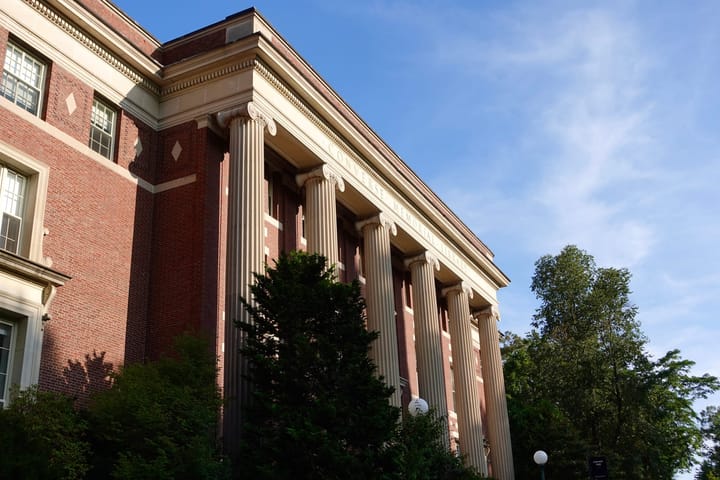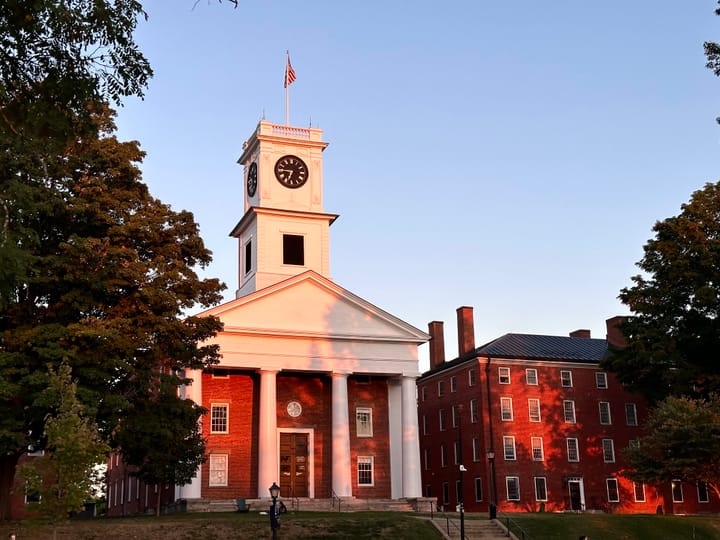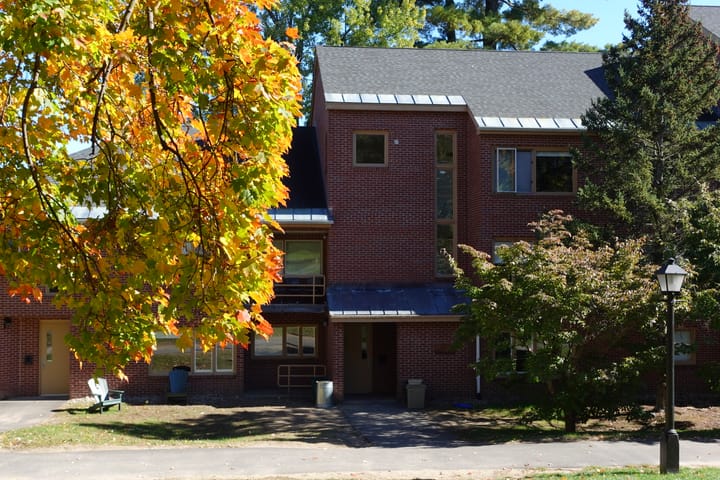Amherst’s Open Curriculum: Who Really Gets to be Well-Rounded?
Managing Features Editor Mira Wilde ’28 considers Amherst’s open curriculum, revealing how its promise of academic freedom is unevenly experienced, and questions whether the college truly supports the initiative and interdisciplinary exploration it claims to value.
Featured prominently on the Amherst College website is its self-proclaimed simple approach to education: “Take courses that excite and inspire you. With no core educational requirements, you can choose the courses that matter to you.”
Yet, in practice, this opportunity to freely explore subjects that interest you is distributed unevenly among the student body. Course flexibility often depends on whether a student is majoring in a science, technology, engineering, and math (STEM) field or in the humanities. Like many others, one of the main reasons I decided to apply to Amherst was its open curriculum and the promise of the freedom to explore a variety of academic disciplines. Arriving at Amherst, I knew I wanted to major in a humanities field, but was open to exploring STEM-oriented courses as well. I was relying on exploration within the open curriculum to figure out the right path for myself. But for students majoring in the humanities, it's much harder to explore STEM classes than it is for STEM students to branch out into the humanities.
This imbalance often begins as soon as first-years meet with their academic advisors. A student who approaches their professor with interest in majoring in biology, math, chemistry, or another STEM field might be encouraged to round out their schedule by taking an introductory English or history course. Meanwhile, a student intending to major in law, jurisprudence, & social thought, classics, or another humanities discipline, is rarely pushed to enroll in an introductory math or chemistry course. Even when such encouragement occurs, it is no small task to convince a humanities student to take a “weed-out” course like introductory chemistry or biology — classes seen as designed to filter out non-majors.
The reality is that a STEM versus humanities divide is present at every institution of higher education, but in Amherst’s case, the open curriculum amplifies this dynamic. The flexibility to choose classes often discourages students from pushing themselves out of their comfort zone, simply because they don’t have to. This unwillingness to try new things is exacerbated for humanities students, as the risk of taking an introductory STEM course that is perceived as extremely difficult often outweighs any potential intellectual benefit.
Natural Causes
This discrepancy has two roots: First, the inherent differences between STEM and humanities instruction in higher education, and second, students’ ability to self-select courses through Amherst’s open curriculum. While Amherst has made strides to increase human-centered perspective within STEM, specific learning approaches are baked into how STEM disciplines are instructed; namely, the knowledge taught in higher-level STEM classes is based on fundamentals introduced in lower-level courses. Humanities courses, in contrast, are centered around the idea of human experience — something that some might argue a student doesn’t need a prerequisite to grasp. But if you want to take a STEM course that caters to a specific niche, you’ll need to have completed multiple semesters of prerequisites.
Take the math department, for example: At Amherst, a student can begin with "Calculus with Algebra" and work their way up to advanced courses covering specific concepts, like “Groups, Rings and Fields” or “Measure Theory.” Enrolling in a class like “Groups, Rings, and Fields,” requires taking at least three prior math courses and earning a high enough grade in a level 200 math class. Taking a course on a specialized topic outside of one’s major is simply not a possibility open to everyone.
This might feel like an obvious reflection. Of course you need to understand the fundamentals of math to take higher-level classes. But let’s examine the course offerings for the history department. Even the lowest numerically rated classes boast titles like “Queer American History, 1625-1890,” “Russian Empire in Eurasia,” and “Japan from Shamans to Samurai” — all of these classes are incredibly focused on a small topic within a large discipline. A history class with a high numerical value might only be open to students of certain class years, or, at most, recommend taking at least one prior class within the discipline. But these courses rarely ever require it; it is easier to take a higher level class in the humanities than in the STEM disciplines, which seem exclusively catered toward majors.
The Consequences
Imagine an Amherst student majoring in English who has mainly taken classes within or adjacent to the department. This student also happens to be from a place where cultural fishing traditions are being threatened by fisheries: Perhaps the commercial practices have caused family members to work or experience harmful environmental effects. The student is interested in the issues of sustainability related to commercial fishing and wants to learn more about it. To their surprise, they find out that Amherst actually offers a class called "Fisheries," which could answer some of their questions. However, this class requires the student to have taken “The Resilient Earth: An Introduction to Environmental Studies” and recommends that students have taken “Ecology.” In all likelihood, this student will not take the course because they don’t have time to take all of the prerequisite courses.
On the other hand, picture a chemistry major who has also mainly taken courses related to their major during their time at Amherst. Growing up, this student might have moved between countries and across continents, and each time they had to pick up new ways of speaking. They discover the class "The Question of Accent," which uses a theoretical perspective to explore many of the dynamics they experienced in their childhood. After their first year, Amherst students are invited to enroll in this class. This student will have no problem taking the class and will get to enjoy engaging with a topic they are interested in and acquiring new knowledge.
While these are very specific examples, similar scenarios play out each time course registration rolls around. The ability to navigate Amherst’s open curriculum in a way that meets all of one’s academic and personal interests seems to be more accessible to students who major in STEM fields. Beyond this, one’s class year can also hinder their ability to fully explore all of their academic curiosities: If an upperclassman humanities student finds a STEM class they want to take, it is possible they won’t even have enough time to fulfill the requirements needed to qualify for the class. In contrast, a STEM student will not be as impacted by a latent discovery of an interesting class and would likely be able to enroll immediately.
This isn’t to say that there aren’t opportunities for humanities students to try out STEM classes: well-known courses like GEOL-104 (colloquially “Rocks for Jocks”), or "Color Study," or "Molecular Gastronomy" are often pursued by upperclassmen as a fun, final, STEM learning experience at Amherst because these courses do not have prerequisites. However, there are fewer of these accessible STEM classes than there are humanities offerings easily available to STEM students. As a result, a dynamic forms where STEM majors can challenge themselves with hard courses outside of their fields, but humanities majors cannot.
Fourth-Class Dynamic
This imbalance of access to the open curriculum has a more tangible impact on humanities classrooms than STEM classrooms. As noted in a 2022 article in The Student, many STEM students cram their schedules with three STEM classes and then enroll in a fourth class to lighten their load. In many cases, this fourth class is a level-100 or -200 humanities course. This is not to say that STEM students enrolled in this fourth humanities class can’t get a lot out of the experience. In many cases, they are incredibly pivotal in cultivating the “well-rounded students who work extensively within their majors, while also exploring the many other courses that spark their curiosities,” the college proudly boasts on its website.
While this fourth-class dynamic fulfills some of the college’s promises, it can fall short on others, namely the promise that the “open curriculum means your classes will be filled with inquisitive, engaged classmates who are committed to the topic.” While many STEM students enrolled in humanities classes are genuinely interested in the topic at hand, the “easy fourth class” phenomena means there’s a chance that STEM students might be less engaged. If students put little effort into these classes because they view them only as GPA boosters and tangential to their true interests, this comes at the detriment of students who care deeply about the topic. STEM students largely don’t experience this phenomenon in their specialized classes because of the difficulty involved with qualifying for those courses in the first place.
Moving Forward
I want to be very careful about avoiding the impression that STEM classes are harder simply because humanities courses have a lower bar for enrollment — after all, the whole point of the humanities is that they are based on the things we all share: human identity. On a larger scale, colleges and universities are experiencing a current humanities crisis — simply put, because more students are pursuing STEM degrees, colleges are trying to make humanities degrees more accessible. I also do not intend to make the argument that the bar for STEM classes should be lowered just so humanities students can enjoy the classes more. In reality, the specific aspect of the open curriculum I’m outlining in this article is situated within a much broader conversation about the complications and benefits of Amherst’s approach to education.
The open curriculum is intended to avoid prescribing learning pathways for students. But, when the open curriculum has hidden dynamics related to access, it falls short of its promise: “Our curriculum offers flexibility and independence. It rewards initiative.” We are forced to wonder whose initiative Amherst truly rewards.





Comments ()